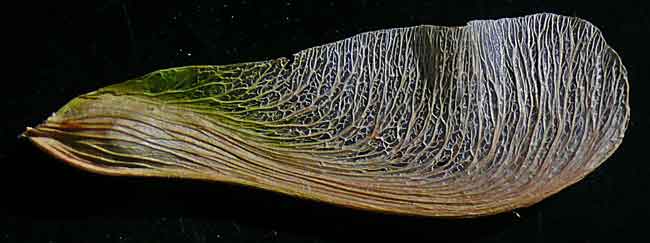Single blade aero rotor - and perfectly balanced too
Submitted by Jeff Buster on Sun, 05/09/2010 - 16:42.

When the wind blows and you follow one of these silver maple seeds as it smoothly spins down to the ground - it might make you wonder why there are not any single bladed wind turbines in commercial production. Since it's Mother's Day, surely we should look to Mother Nature for a little guidance and suggestion as to how to capture wind energy with the simplest and most efficient rotor design ....
I have collected a bucket of these with the intention of setting (at night) a bright light shining up from the ground, and videoing the dumped bucket of seeds as they spin down to the camera.
( categories: )
|
Bad lands watershed and dragon fly wing
What does it mean that a land structure looks life a plant structure, or that a plant structure looks like an insect structure?
Dendritic Drainage Patterns
Just one drainage system:
Dendritic drainage system
Dendritic drainage systems (from Greek δενδρίτης, dendrites, "of or pertaining to a tree") are the most common form of drainage system. In a dendritic system, there are many contributing streams (like the trunk and bark of a tree), which are then joined together into the tributaries of larger rivers. They develop where the river channel follows the slope of the terrain. Dendritic systems form in V-shaped valleys; as a result, the rock types must be impervious and non-porous.[2]
More drainage systems at the source of the above... http://en.wikipedia.org/wiki/Drainage_system_(geomorphology)
Also:
From: http://www.tulane.edu/~sanelson/geol204/riversystems.htm
----------------------------------------------
By refusing to deal honorably with others, you dishonor yourself.
Leading edge vortex - birds and seeds
A Realneo reader friend send me an email this morning with this link to Science Daily where there is a June 19, 2009 description of the aerodynamic characteristics of the maple seed. Autorotation - might have implications for the design of swirling parachutes—
The article remarks; "This use of a leading-edge vortex to increase lift is remarkably similar to the trick employed by insects, bats, and hummingbirds when they sweep their wings back and forth to hover. The finding means that plants and animals have converged evolutionarily on an identical aerodynamic solution for improving their flight performance."
So the appearance similarities are confirmed as being a non-random because the functions of insect wings and the seed "wing" are non-random - both have evolved to develop aerodynamic lift. What about watersheds - hydraulics, not lift is the object there.